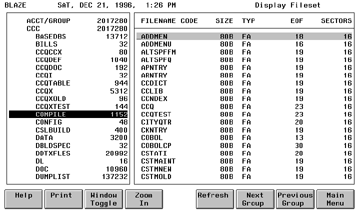
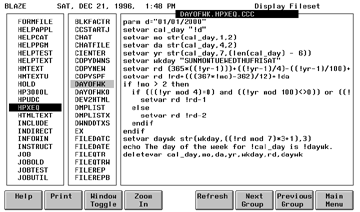
System Manager's Toolbox
Developer's Toolbox
Lund Performance Solutions
240 Second Ave. S.W.
Albany, Oregon 97321
Tel: 541.926.3800
Fax: 541.926.7723
E-mail: info@lund.com
WWW: www.lund.com
The System Managers Toolbox and the Developer's Toolbox each has a license fee of $2,995 per copy. Yearly support for each is $540. An evaluation copy of the Toolboxes is available upon request.
Review by John Burke
Every system manager or software developer who has been on the job for at least, oh say one week, has a "toolbox" of utilities, command files and code snippets, etc. that he or she uses over and over to inprove effectiveness. The System Manager's Toolbox and Developer's Toolbox from Lund Performance Systems (LPS) are ready-made collections of such utilities.
The utilities in the System Manager's Toolbox perform tasks such as file management in a windowed environment, finding text strings in files, fast file copying of MPE, KSAM, or TurboIMAGE files, analysis of memory usage, and elimination of idle users.
The Developer's Toolbox is a collection of tools that aid the software engineer in the design, development, debugging and optimization of traditional programs. With these tools you can, for example, modify programs without recompilation, use optimized replacements for a number of standard often-used intrinsics, report the calling sequence of any Native or Compatibility Mode intrinsic (including your own library intrinsics), and add hypertext-like help and messaging facilities to MPE help.
First, a little history. The tools in the System Manager's Toolbox and Developer's Toolbox used to be called Nuggets and were marketed for many years by SRN. When SRN decided to re-focus on its core products, Lund Performance Solutions took over the marketing and support of the Nuggets, re-packaging them as the Toolboxes. This is a natural fit, given LPS's expertise in performance, since the aim of most of the tools in the toolboxes is to help you run your system and develop your software more effectively and efficiently. The tools were originally developed and continue to be maintained by noted 3000 guru Stan Sieler. LPS provides user support.
You will notice that some of the Toolbox utilities are similar to CSL or freeware utilities In fact, limited versions of several of the tools have been made freely available by their author. But the Toolbox utilities have more features than their freeware cousins, present a common, consistent user interface and are supported by a solid, recognized company -- a not insignificant fact, especially when updating OS levels. Some of the utilities overlap with other popular third party tools and a couple provide functionality that is now part of MPE/iX, though in an easier to use fashion. Most of the tools, however, are totally unique.
Some of the tools use Wingspan for screen display. Wingspan has been an unfortunate marketing failure. It is an absolutely fantastic product that provides a windows interface for terminals or PCs running terminal emulation software. Complete with support for pop-up windows and pull down menus, Wingspan eliminates the need for complex PC windows front ends. It's true, Wingspan t does not support a rodent; but the arrow keys and page keys all work as expected. On a network, the difference in response between a Wingspan screen and a local PC windowed environment is negligible. Even on a 9600bps serial connection, the performance is quite startling. My New Year's wish: HP acquire Wingspan and bundle it into FOS.
With a total of 23 tools, I cannot give much detailed information about any one. I have tested all the standalone utilities, and all work as advertised. I am going to give a brief description of each tool so you can determine if it would be of use to you.
The System Manager's Toolbox
The System Manager's Toolbox consists of 15 utilities: ACAP, BETIMES,
BLAZE, CASPER, ETC, GRANT, KLONDIKE, KNOCKOUT, MAGNET, MODA, PAGES,
REDWOOD, REP, SHOT and TINDEX.
ACAP allows you to view and alter the capabilities and attributes of both NM and CM program files. It will also display informational messages identifying "abnormal" capabilities, i.e. NMSTACK=0. Almost any program file attribute can be altered or viewed, including the status of the OCT flag for compatibility mode programs.
BETIMES allows you to change the current time or date on an HP3000 9xx without rebooting the computer. For MPE/iX versions 5.0 and later, BETIMES uses the MPE/iX command SETCLOCK. You might think BETIMES has been superseded by the SETCLOCK command, but BETIMES is more idiot-proof and contains a number of functions that make various time/date changes easier.
BLAZE is a file management tool. It uses a terminal-based windows interface (Wingspan) to perform file management operations on filesets. It's the point and shoot interface to MPE we've always wanted -- think Windows 3.x File Manager or Windows 95 Explorer (See Figures 1 and 2 below).


BLAZE even has an interface to MAGNET (see below) for constructing file sets based upon content. Unfortunately, BLAZE currently does not support HFS. If it did, I'd recommend the whole package based just upon the BLAZE tool.
CASPER is a SPOOK emulator. An interesting extension is the WATCH command that will echo to the user, at user defined intervals, information written to a spoolfile as it is created -- a progress monitor of sorts.
ETC gives file information for selected processes. For example, ETC can be used to predict when a sequential file access will reach end of file (EOF). ETC predicts current record pointer and the known EOF based upon system load. ETC can also display file information that is not normally available in a single program.
GRANT provides the user with all possible capabilities. This is a dangerous, though useful, tool and should be carefully protected via lockword.
KLONDIKE can load or "fetch" data files into memory. Once loaded into memory, KLONDIKE can freeze the file in memory so that it isaccessible immediately to programs that require it. KLONDIKE can later thaw or unload the file from memory. Note that freezing files can have a significant impact on performance -- both positive and negative -- so this tool should be used with extreme caution.
KNOCKOUT aborts sessions that have become idle according to user defined criteria. KNOCKOUT is typically run as a background process, monitoring all sessions; it aborts sessions that have become inactive for a user-defined amount of time.
MAGNET scans user defined filesets for the presence of one or more text strings using a flexible pattern matching scheme. It scans normal ASCII flat files and QEDIT work files by default, thus it will not hang on a message file. However, other non-PRIV files can also be specified. A number of different display options are available. This latest version of the System Manager's Toolbox includes a windowed interface version of MAGNET (See Figures 3 and 4 below).
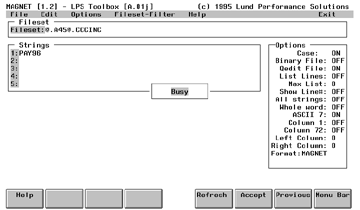
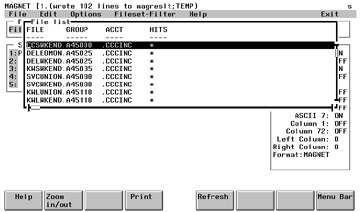
MODA simplifies the task of managing (creating/modifying) HP 3000 accounts, groups and users. Its ability to clone account structures or put them into sync is a particularly cool feature.
PAGES gives an exhaustive analysis of memory use at any point in time. It can be used over a period of time under different load conditions to help determine whether adding memory would improve system performance.
REDWOOD determines individual file usage statistics by examining the file close log records in the system log files. It will also report any I/O errors recorded in the system log files.
REP can copy or replicate files. It is particularly useful for copying entire TurboIMAGE databases and KSAM files. A number of options allow you to adjust the characteristics of the target files.
SHOT provides a comprehensive snapshot of process activity and can also be used to alter some aspects of process activity (BREAK, RESUME, PRIORITY, and KILL).
TINDEX verifies tapes in a variety of formats: NMSTORE, CMSTORE, DBLOAD, (Classic) MEMDUMP, HPUX Core tapes, SPOOK, (classic) DUX, HPPA INSTALL and (Spectrum) MEMDUMP tapes. It also has limited support for Unix TAR tapes. It combines the functionality of the old CM VALIDATE with the NM VSTORE and adds a whole lot more.
The Developer's Toolbox
The Developer's Toolbox consists of eight utilities: AVATAR, CAPTURE,
CHRONOS, CSEQ, EZHELP, FASTLIB, WILDCARD and XDSMAP.
AVATAR is for the sophisticated software engineer. Its decompiler capabilities include finding, viewing and modifying the contents of any NM program file, executable library or relocatable library. It is similar in feel to HP's DEBUG and requires that the user have an understanding of HP-PA assembly language, procedure calling and parameter passing conventions.
CAPTURE is used to capture all or part of a terminal or PC terminal emulator screen buffer to either a printer or a disk file. CAPTURE can be run standalone or called programmatically from an XL (so you can use it in your software to control screen output). It is a much souped up PSCREEN.
CHRONOS is a library of procedures for manipulating date and time information. It supports a seemingly endless list of formats, including forms that lend themselves to arithmetic calculations. CHRONOS would typically be used to translate a date or time from a stored format in a database to a display format on a screen or report, or to calculate the amount of time between two events (for example, the aging of receivables).
CSEQ displays NM and CM intrinsic calling sequences as defined by SYSINTR- and SPLINTR-type files. It is much more convenient than rummaging through possibly inaccurate manuals or, in the case of library routines you've developed and failed to document, the source files looking for the parameter calling sequence.
EZHELP is a terminal window-based file browser for files formatted according to the MPE HELP catalog format. Even if you do not have any other HELP catalogs on your system EZHELP is a wonderful replacement for MPE HELP. Pop-up, scrollable windows contain lists of topics and items (See Figure 5 below).
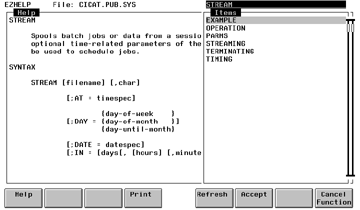
FASTLIB is a library of functionally equivalent, high performance replacements for the HP intrinsics ASCII, DASCII, BINARY, DBINARY and CTRANSLATE. FASTLIB is available in both CM and NM versions. The Toolbox comes complete with two test programs that report timing statistics for the various routines. On my system (a Series 918 running MPE/iX 5.5), the CTRANSLATE routine in FASTLIB clocked in at an average time that was almost 15 times faster than the HP version.
WILDCARD is a library of procedures providing a solution for two common programming tasks: building a fileset from a complex fileset specification and performing pattern matching in strings.
XDSMAP is a library of plug-compatible modules for replacing calls to extra data segments (a common data structure used on classic systems) with calls to mapped files (up to 20 times faster). XDSMAP makes migrating CM code that uses extra data segments to NM code using mapped files a snap because the routine names and calling sequences are identical.
Conclusion
If you manage HP 3000s, there are utilities in the System Manager's Toolbox
that you will routinely use -- and wonder how you ever got along without.
If you write software for the HP 3000, the Developer's Toolbox will enable
you to write better, more efficient software in less time.